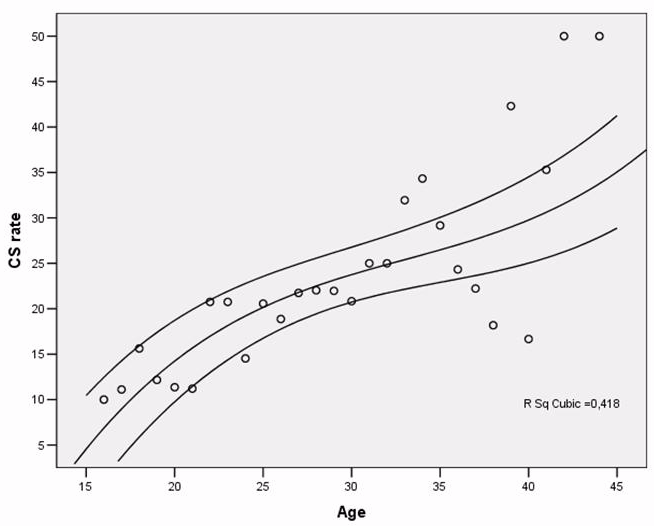|
Τίτλος – Title
|
The effect of increasing maternal age on caesarean section delivery rates in primigravidae women with induced labours for all indications
|
|
|
Συγγραφέας – Author
|
1Δημήτριος Παπουτσής, 2Αγγελική Αντωνάκου |
|
|
Παραπομπή – Citation
|
Papoutsis D., Antonakou A.: The effect of increasing maternal age on caesarean section delivery rates in primigravidae women with induced labours for all indications, Review Clin. Pharmakol. Pharmakokinet. 29: 81-85 (2015)
|
|
|
Ημερομηνία Δημοσιευσης – Publication Date
|
01 Ιουλίου 2015 – 2015-07-01
|
|
|
Γλώσσα Πλήρους Κειμένου –
Full Text Language |
Αγγλικά – English |
|
|
Λέξεις κλειδιά – Keywords
|
Καισαρική Τομή, Ηνωμένο Βασίλειο –
Induced labour, primigravidae women, caesarean section, maternal age, parity, delaying childbirth, United Kingdom (UK) |
|
|
Λοιποί Όροι – Other Terms
|
άρθρο, στατιστική μελέτη – |
|
|
Περίληψη – Summary
 |
Objective: To investigate the effect of increasing maternal age on the delivery outcome in primigravidae women with induced labours. |
|
|
Αναφορές – References
|
1. NICE Guideline. Induction of Labour. National Collaborating Centre for Women’s and Children’s Health. National Institute for Health and Clinical Excellence. London: RCOG Press; 2008. 2. Zhang J, Troendle J, Reddy UM, Laughon SK, Branch DW, Burkman R, et al. Contemporary cesarean delivery practice in the United States. Am J Obstet Gynecol 203:326.e1–326.e10 (2010). 3. Talaulikar VS, Arulkumaran S. Failed induction of labor: strategies to improve the success rates. Obstet Gynecol Surv 66:717-28 (2011). 4. Caughey AB, Sundaram V, Kaimal AJ, Cheng YW, Gienger A, Little SE, et al. Maternal and neonatal outcomes of elective induction of labor. Evid Rep Technol Assess (Full Rep) 176:1-257 (2009). 5. Rane SM, Guirgis RR, Higgins B, Nicolaides KH. Preinduction sonographic measurement of cervical length in prolonged pregnancy: the effect of parity in the prediction of the need for Cesarean section. Ultrasound Obstet Gynecol 22:45-8 (2003). 6. Office for National Statistics. Births in England and Wales, 2012. (2013). 7. Smith GC, Cordeaux Y, White IR, Pasupathy D, Missfelder-Lobos H, Pell JP, et al. The effect of delaying childbirth on primary cesarean section rates. PLoS Med 5:e144 (2008). 8. Roos N, Sahlin L, Ekman-Ordeberg G, Kieler H, Stephansson O. Maternal risk factors for postterm pregnancy and cesarean delivery following labor induction. Acta Obstet Gynecol Scand 89:1003-10 (2010). 9. Takahashi H, Watanabe N, Sugibayashi R, Aoki H, Egawa M, Sasaki A, et al. Increased rate of cesarean section in primiparous women aged 40 years or more: a singlecenter study in Japan. Arch Gynecol Obstet 285:937-41 (2012). 10. Bereczky LK, Kiss SL, Szabó B. Increased frequency of gestational and delivery-related complications in women of 35 years of age and above. J Obstet Gynaecol 35:115-20 (2015). 11. Grangé G, Pannier E. [Effect of smoking on mode of delivery and per partum hypoxia and acidosis]. J Gynecol Obstet Biol Reprod (Paris)34:3S146-51 (2005). 12. Lurie S, Ribenzaft S, Boaz M, Golan A, Sadan O. The effect of cigarette smoking during pregnancy on mode of delivery in uncomplicated term singleton pregnancies. J Matern Fetal Neonatal Med 27:812-5 (2014). 13. Sebire NJ, Jolly M, Harris JP, Wadsworth J, Joffe M, Beard RW, et al. Maternal obesity and pregnancy outcome: a study of 287,213 pregnancies in London. Int J Obes Relat Metab Disord 25:1175-82 (2001). 14. Torricelli M, Voltolini C, Conti N, Bocchi C, Severi FM, Petraglia F. Weight gain regardless of pre-pregnancy BMI and influence of fetal gender in response to labor induction in postdate pregnancy. J Matern Fetal Neonatal Med 26:1016-9 (2013). 15. Baranova A, Gowder SJ, Schlauch K, Elariny H, Collantes R, Afendy A, et al. Gene expression of leptin, resistin, and adiponectin in the white adipose tissue of obese patients with non-alcoholic fatty liver disease and insulin resistance. Obes Surg 16:1118-25 (2006). 16. Crane JM. Factors predicting labor induction success: a critical analysis. Clin Obstet Gynecol 49:573-84 (2006). 17. Grobman WA. Predictors of induction success. Semin Perinatol 36:344-7 (2012). |
|
|
Σχετικές Εργασίες – Relative Papers
|
Online ISSN 1011-6575
